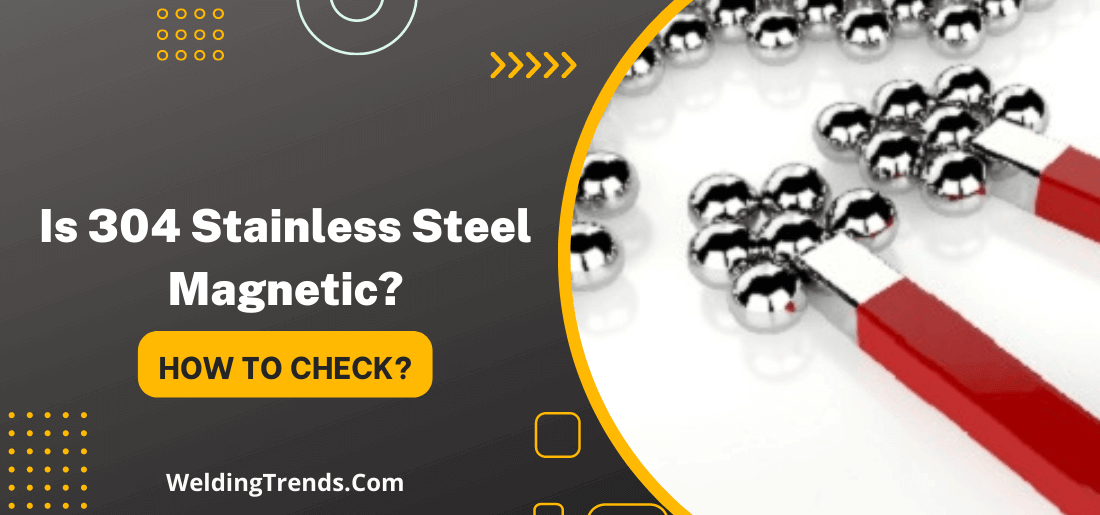304 stainless steel is a type of alloy that can be made magnetic, but it depends on the composition of the metal. Some alloys of 304 stainless steel are more likely to be magnetic than others.
It is important to note that just because a piece of 304 stainless steel is magnetic, doesn’t mean it is automatically lower quality. In fact, depending on the use case, a magnetically responsive 304 stainless steel may actually be preferable!
In this blog post, we will discuss the reasons why 304 stainless steel might become magnetic and how this can affect its usefulness for various applications.
Does 304 stainless steel have a magnetic field?
Yes, 304 stainless steel has a magnetic field. This is because the austenitic structure of 304 stainless steel gives it slightly different properties than other types of stainless steel. When exposed to a magnetic field, the nickel in 304 stainless steel realigns itself with the field, creating a small amount of magnetism.
However, this magnetism is not strong enough to be noticeable or to affect the steel’s properties. 304 stainless steel is still non-magnetic after being cold worked. 304 stainless steel does not become significantly less magnetic when cold worked, as do some other austenitic steels. However, it can become slightly more magnetic than it was before cold working.
This is because the cold work process rearranges the atoms in the steel, causing them to align differently than they did before. This realignment is usually too small to be noticeable or to affect the steel’s properties, but it can be measured with very sensitive equipment.
Some types of stainless steel, such as 430 and 434, become slightly more magnetic after cold working than they were before. This is because these steels contain more ferrite, which is a magnetic form of iron.
How can you determine if a particular piece of 304 stainless steel is magnetic or not?
The best way to determine if a piece of 304 stainless steel is magnetic is to use a magnet. If the magnet sticks to the metal, then it is magnetic. If the magnet does not stick, then the metal is not magnetic.
You can also use a gaussmeter to measure the magnetic field strength of the 304 stainless steel. If the gaussmeter reading is greater than zero, then the metal is magnetic.
Also, 304 stainless steel will be attracted to a magnet if it is placed in a magnetic field. This is because the nickel in 304 stainless steel realigns itself with the magnetic field, causing the metal to be attracted to the magnet.
What are some applications where it might be advantageous to use a magnetic stainless steel alloy instead of regular 304 SS alloy?
Some applications where it might be advantageous to use a magnetic stainless steel alloy instead of regular 304 SS alloy include:
Automotive exhaust systems: Automotive exhaust systems need the steel to be attracted to the magnets in the sensors so that the sensor can accurately measure the exhaust flow.
Magnetic resonance imaging (MRI) machines: MRI machines need the steel to be attracted to the magnets in order to create a clear image.
Sensors: Sensors and motor magnets need the steel to be attracted so that they can function properly.
Speakers and loudspeakers: Speakers and loudspeakers need the steel to be attracted in order to create sound.
Magnetic separation equipment: Magnetic separation equipment uses magnets to separate metals and the stainless steel needs to be attracted to the magnet in order to be separated.
Magnetic stirrers: Magnetic stirrers use magnets to stir liquids and the stainless steel needs to be attracted to the magnet in order for the stirrer to work.
Magnetic jewelry: Magnetic jewelry is made using stainless steel that is attracted to magnets.
Magnetic therapy products: Magnetic therapy products use magnets to help relieve pain and the stainless steel needs to be attracted to the magnet in order for the therapy to work.
All these applications require stainless steel that is attracted to a magnet.
FAQs – Is 304 stainless steel magnetic?
What grade of stainless steel is magnetic?
The grade of stainless steel that is magnetic is called ferritic stainless steel. This type of stainless steel contains more iron than austenitic stainless steels and as a result, it is magnetic.
Is 316 stainless steel magnetic?
No, 316 stainless steel is not magnetic. This is because 316 stainless steel contains molybdenum, which prevents the steel from becoming magnetic.
Which stainless steel is not magnetic?
The type of stainless steel that is not magnetic is called austenitic stainless steel. This type of stainless steel contains chromium and nickel, which prevent the steel from becoming magnetic. Some of these are grades 304, 309, 310 and 321.
How do you demagnetize 304 stainless steel?
You can demagnetize 304 stainless steel by heating it to a temperature above the Curie point and then cooling it. The Curie point is the temperature at which a material becomes magnetically saturated.
For 304 stainless steel, the Curie point is around 790 degrees Celsius.
You can also demagnetize 304 stainless steel by passing it through an electric field. This will cause the magnetic moments in the steel to align in the opposite direction and as a result, the steel will become demagnetized.
Does 304 stainless steel work on induction cooktop?
Yes, 304 stainless steel works on induction cooktops. This is because 304 stainless steel contains chromium and nickel, which are both ferromagnetic materials. That’s why 304 stainless steel is attracted to a magnet and can be used on induction cooktops.
Conclusion:
Ferromagnetic materials, such as iron, nickel and cobalt, have so many paired electrons that their atomic fields line up and create a strong attraction to magnets. Stainless steel is an alloy of ferrous metals, meaning it has some amount of iron, so it is partially magnetic.
It contains a small amount of nickel, which makes it responsive to a magnetic field. However, the level of magnetism in 304 SS is not strong enough to attract or repel other objects like iron filings.
If you need a material that is more strongly affected by magnets, you may want to consider using 316 stainless steel instead.




